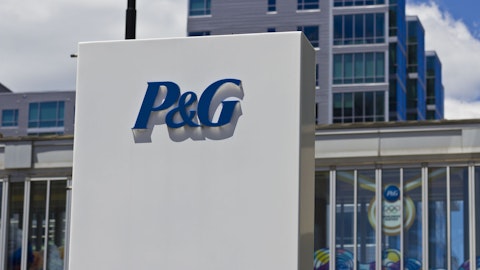Laurent Vasilescu: Very helpful. Thank you very much.
Operator: Our next question comes from Dana Telsey with Telsey Advisory Group. Please state your question.
Dana Telsey: Good afternoon everyone. As you think about the initiatives for enhancing the business in all the brands, frankly, what do you see is the inventory structure going forward, how that changes given the wholesale account base and how they’re placing orders go forward? Thank you.
Benno Dorer: Yes, hi, Dana, thank you. Yes, I mean certainly, inventory has been a challenge. It’s been an overhang for us for a couple of quarters and continue to certainly persist. Our inventories kind of nearly doubled on an absolute value, if you just look at the balance sheet, clearly, there’s an impact there of the in-transit inventory on the comparison. When you back that out, we’re up about 67% on a gross, kind of, comparable basis year-over-year with most of the increase in the Americas. I think as you think about moving forward, we actually think there’s opportunity to get more efficient with our inventory as we get closer to market. One of the challenges that we faced this year is the elongated lead times led to earlier buys, which ultimately led to lower forecast accuracy, which created excess inventory that’s been exaggerated by the higher level of cancellations through the fall and even the late deliveries at the same time, which also led to higher cancellations.
So we’ve got a lot of inventory today. Fortunately, it’s primarily in core carryover replenishment inventory. We’ll carry that moving forward into fiscal year 2024, even after a pretty substantial reduction in inventory here Q4. And we’ve got plans in place. It really is contemplated in the next season in terms of merchandising and assortment plans, and we’ll work our way through it. But if you think about where we’re moving forward, our direct-to-consumer business becoming a larger percent of the total, we think that’s a good thing, overall. I mean, from an inventory management standpoint, certainly, we love the idea that we have a large outlet network to move through excess inventories, and that’s always our first avenue. But the work that we’re doing to more modernize the supply chain, and Benno talked about some of the things that we need to be doing there, we think will allow us to be more efficient from an inventory utilization moving forward, not less.
Dana Telsey: Thank you.
Operator: Thank you. And our next question comes from Michael Binetti with Credit Suisse. Please state your question.
Michael Binetti: Hey, guys. Thanks for taking the question, here. I guess, just the first one, Benno, the company is known over long periods as a best-in-class supply chain operator. You pointed to a medium-sized list there of items that you think — it sounds like you think got off track. I’m curious what you think happened in the supply chain, what do you think has changed there? And then maybe, this one is for Matt. But I think to get to double-digit EPS growth on the low single-digit revenue growth next year, trying to think about how you’re building that. I think you need to pencil out to about 100 basis points of EBIT expansion — EBIT margin expansion. Maybe just trying to help us think about some of the high-level drivers there?
I’m assuming it tilts to the back half of the year, given the comments on Vans revenues in the first half and how to think about the gross margin expanding next year with the inventory up relative to sales in the fourth quarter heading into the year?
Benno Dorer: Hey, Michael, thanks for the question. I’ll take the one on supply chain. And I will say coming into this role. Clearly, as you say, supply chain is known to be a whole much strength for VF. And I think, in general, and over a prolonged period of time, that’s a reputation that’s well reserved. But that doesn’t mean that we can’t be clear eyed about the issues. And some of the issues, certainly, I think, were known before, especially the longer lead times on the manufacturing and freight. But I would say, these issues were exacerbated in Q3, given that it’s the high-volume quarter, but also because there was so much volatility, high promotions to get rid of inventory, order cancellations from customers in part because the consumer, of course, is somewhat cautious, but in part also, because we haven’t been able to meet their expectations and therefore, they cut cancellations in anticipation of perhaps further customer service issues.
And then, you add the strain from the longer lead times, that really gives you a confluence of issues that created a perfect storm in this quarter. And I would say that, part of it is maybe that my added perspective coming into the business shift is the perspective within our team a little bit and our own role in these issues. But the fact is this quarter had a lot of volatility and pressure on the supply chain. And it did expose some of the internal issues, and we’ll talk about them all fixable, but certainly requiring a lot of focus. So maybe first, where we are is against the higher manufacturing and shipping lead times, we’re seeing improvements. Those have started to come down, and we need to continue to focus on that trajectory. The customer service clearly is unsatisfactory.
And we’re putting a lot of work in place to be back on track by the end of the first half and fiscal year 2024. Matt talked about higher excess seasonal inventory. We’re making good progress and assuming that to be more normalized by the end of Q4 of this fiscal year. And our cost to serve clearly are higher, and we’ll see improvements throughout fiscal year 2024 starting with Q1, so this all is going to stay with us a little bit, but we’re expecting improvements from here on out. So specifically, what we’re going to do about it is — first off, this is a business-by-business action plan. The businesses that are most affected by this are the North Face and Timberland. So those businesses saw growth in Q3, but they could have frankly seen more growth in the quarter.
Had we not held them back somewhat through these issues. So we have So we have a high focused on distribution network, optimization. We are working on peak warehousing capacity planning, so we don’t have to use as many external facilities which you know, gives you inflexibility and also gives you higher costs. We need greater agility to react to short-term changes. So the business by business action plan is very detailed and varies a little bit by business. We’re working with our strategic supply chain partners to address the lead times and costs, which will include improving ocean freight costs and we’re starting to see positive movement there and expect quite a bit of improvements starting in fiscal year 2024. Importantly, we need to return to better sales and operations planning.
And again, to your question, what happened? I would say that’s an area where the team would suggest that we’ve lost some focus during the COVID period, and we’re now getting back to reestablishing strong routines. It seems that this company knows that this company is well capable of executing and as a complement, also as an executive team, we’re spending a lot of time focusing on this. We have five weekly meetings. We are eliminating barriers to getting rid of these problems. And we’re helping with agile decision-making, which certainly is going to make a big difference. So I would say the overall theme here is operating discipline, and that’s something that VF has been very good at and that’s something that we can reinstill in the business.
We’re taking aggressive actions, we’re seeing improvements. And beyond that, we’re also advancing the strategic work to transform our supply chain to be more digitally led, more automated, more agile and more consumer-centric. That’s worth that our EVP overseeing the supply chain, Cameron Bailey, outlined in the September Investor Day. And I would say, the short-term work that we’re doing gets us back from where we are to good. And then this more strategic work gets us back from good to great, and that’s certainly our aspiration. And again, that’s all within our control.





